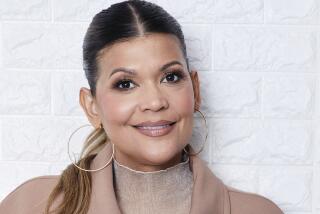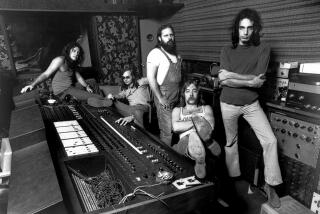Josh Kun, new MacArthur fellow: We use food and music to draw boundaries, but also cross them
Josh Kun was awarded the MacArthur âGeniusâ Fellowship for his work as a cultural historian, using ephemera and pop culture artifacts to explore who we â particularly we Angelenos â are. Kun, a professor at USC, is the author of the books âTo Live and Dine in L.A.â and âSongs in the Key of Los Angeles,â both based upon research done in the L.A. Public Library. There is more about him here; he spoke to us further about books and his work.
There were public outreach efforts for âTo Live and Dine in L.A.â and âSongs in the Key of Los Angelesâ that included concerts, readings, a âlive mixtapeâ and an art installation. How do you see the role of the books within what you do?
It was really important for me with both of those projects that there be a book, and that we always approached the book, collectively, as the foundation of the project. Obviously, the special collections and the archives that the books are based on are the reason that the books can exist, but the books themselves became the cornerstone of whatever other kinds of projects or events or programs that spun off from them. We always started with the book, because the book not only established the visual archive, but it also established the critical argument and the cultural histories that I was trying to tell about the archive. Without that as a foundation, I think the public programs that we did wouldnât have made much sense; or they would have been more arbitrary and haphazard. I like to think of the book as the cornerstone of the thinking that created the thread that holds all of the activities that we did together.
How did those two books come together?
Iâve been very lucky with Angel City Press, because theyâre a smaller publishing house, we had a lot of flexibility, They were just incredible in terms of the design work. Amy Inouye was the designer on both books and I was able to work very closely with her. And with those books, I think most of the comments that I get, people say the book is so beautiful! Which has very little to do with me. The design of those books, I think, has helped put them on peopleâs tables.
I think itâs fascinating that youâve been able to bridge the conversation around the artifacts from the academic level to the popular level. You operate in multiple registers, but thatâs got to be a challenge.
Itâs a big part of what I try to do.That impulse for me, is central to why I became an academic. Iâve never been that invested in academic work that only lives in the space of a professional field. I think thatâs very important and I value my colleague and the professional histories that Iâve been lucky to be a part of. But perhaps because I got my PhD in ethnic studies at UC Berkeley, I was trained in a department that came out of a long history of Third World activism and civil rights activism and social movement work, by people who ingrained in me that our scholarship and academic work, if it matters in the way we want it to matter, kind of urgently, always creates conversations between the classroom and the campus and the city that surrounds us and moves through the campus itself. And we, if possible, should do work that is accessible to multiple publics, especially to the publics and audiences who weâre writing about, who weâre studying and who weâre researching. Itâs something I struggle with with every project. I struggle with it with my students; I openly talk about how I feel like sometimes I get it kind of right and sometimes I fail and itâs something I keep trying to do in my writing. Itâs very difficult to get right. I think the library projects have been a really great opportunity to do that in a concrete way, precisely because there is this archive that people can connect with thatâs a very humble archive â restaurant menus, sheet music â objects that some people think have been forgotten, but that are also intimate, things that people hold onto. A menu from a favorite meal; a piece of sheet music from a grandparent perhaps. Theyâre loaded with memories and stories. And I just, with both projects, tried hard to pay respect to the memories that are encoded in those archives. To do that, I think, you need to have academic rigor and bring scholarship to it,which I tried to do, but you also have to be a good storyteller so it connects with people. If I pulled that off in any way, Iâm very happy.

Your first two books â âAudiotopiaâ and âYou Shall Know Us By the Trail of Our Vinylâ â were essentially about music, but then you went from music to food.
Food was very new for me â Iâm not a food expert or food historian. But food and music, what connected them for me, both are these things that on the one hand are super personal, that people can claim: this is my song, my music, this is my food, the food of my family, the food of my community, and we can use food and music as a way to draw borders around ourselves. And to create in-group maps of life and culture. And on the other hand, theyâre also two of the primary things that allow people to connect across cultural borders and boundaries.
They draw boundaries and they cross them. And I think there was something about that phenomenon that really interested me in terms of their potential for creating new kinds of conversations about cultural life in Los Angeles.
Can you see the fellowship advancing the next book? And can you tell me anything about what it might be?
Itâs been so new and so overwhelming that it has not sunk in. The notion of having a programmatic idea of what it can do for me, I wouldnât even presume to know. However, what it has done, itâs both emboldening on the one hand in the sense that it really makes you feel like Oh, OK, I can do this, and I can do more, and I should maybe do more in more experimental ways, or I should keep pushing in deeper ways. And on the other hand itâs a pretty heavy responsibility. I look at this and Iâm very humbled, very very humbled by what this fellowship stands for. I want to take it very seriously, and I can only hope that my next project lives up to the standard that the fellowship talks about.
In that vein, are there any prior fellows whose work you have read or admired?
Many many many. The freshest in my memory would be a couple of last yearâs fellows, especially in the world of writing and arts and culture. Ta-Nehisi Coates, Lin-Manuel Miranda. These are names of people I study and I teach, think about and read and talk to my daughter about â these are very important people in my life as a fan, as an educator. I think itâs a little crazy that my work will somehow live in the same ecology â at least on the website â with them. Itâs something that makes me want to work harder, and reach for more things.
2016 MacArthur fellows:
More to Read
Sign up for our Book Club newsletter
Get the latest news, events and more from the Los Angeles Times Book Club, and help us get L.A. reading and talking.
You may occasionally receive promotional content from the Los Angeles Times.







